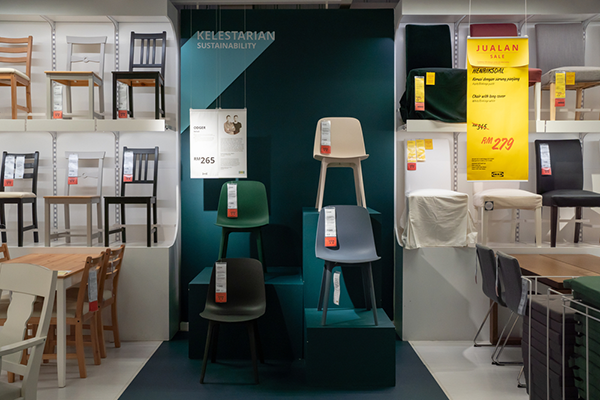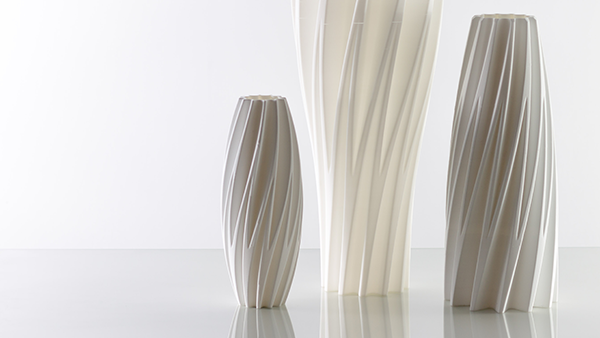
Recycled plastics, the latest craze among designers
At a time when protecting the environment is no longer simply a topic of discussion but has become a grassroots movement, many designers are focusing their efforts fully on the environmental impact of their creations. The idea today is to create differently: optimal use of resources, recyclability of products, integration of recycled materials, upcycling (recovery of materials or products no longer in use in order to transform them into materials or products of higher quality or utility, i.e. recycling “upwards” as it were); eco-design is becoming second nature in all areas of industry. Pressure from consumers and civil society, as well as new regulatory obligations have come to the fore. Greenwashing is out, and it is time for real action. Many design houses and creators are now convinced that we need to change our habits. They are helping us to do so with conviction and... sincerity.

Re-using used bottles to make a stained-glass wall in a shopping mall, as seen here in Thailand, is a perfect example of upcycling. |
Change begins with the choice of materials. The popularity of the most ephemeral materials, often associated with fast fashion and packaging, is currently waning. The aim is to make objects last as long as possible and to ensure that all materials, whatever they may be, can be re-used or recycled. This translates into a much more streamlined style and the use of monomaterials to avoid, for example, a fake gemstone stuck on an ABS plate making the object aesthetically obsolete the day it comes off. This is a first step towards eco-design, but it is not the most decisive. Designers and the brands for which they make their creations, always on the lookout for the latest trends, are now striving to find ever more original recycled materials. Ikea, for example, has added the Order chair to its catalogue. The chair’s texture looks for all the world like cardboard and therefore creates the most original look. The chair is actually made from recycled PET and sustainably-grown wood fibres. This choice is far from trivial considering that the Swedish giant's business model is based on mass production.

The Odger chair from Ikea is used worldwide and is made of recycled PET and wood fibres. |
Designers love the bottle
Recycling marine waste, especially fishing nets, which are usually made of polyamide, is one of the major trends of the moment, at least in the clothing industry. Many start-ups are now proposing solutions to recycle them into a new fibre that is easy to weave and thus to use when designing new clothing.
Among the avant-garde brands are Spain's Ecoalf, one of the pioneers in this field, which has been offering a range of clothing, shoes and accessories made from waste recovered from the ocean for more than 10 years (lien vers interview) and Germany's Adidas, which has succeeded in selling its recycled polymer-based products to fashionistas around the world.

Many fishermen around the world are involved in collecting used nets to be used to manufacture a new polymer fibre. |
For Adidas, this approach has even become a leitmotif, as its global ambitions are so high. For example, it did not hesitate to modify its iconic Stan Smiths (sneakers inspired by the world of tennis and bestsellers for over 50 years). Since March 2021, this shoe model contains 50% recycled polyester. The environmental impact is far from neutral as this sneaker is sold by the tens of thousands worldwide. The German brand hopes to reach 100% recycled polyester by 2024.
|
It also sells a pair of fully recyclable running shoes which must be returned to the manufacturer once they reach the end of their life. The polymer fibres are then recycled and used to manufacture new sports goods. And for those who still have doubts about the technical qualities of such models, this shoe has enabled athletes to break records in the half marathon. |

Making changes to an iconic object is a risky proposition. Adidas successfully did this with its Stan Smith shoes. |
Finally, it would be unfair not to mention the Colombia brand. It is one of the forerunners in the field that has been taking its carbon footprint very seriously for a long time now by selling ranges of products that are eco-designed down to the smallest detail. Some of these garments are white, for example, in order to avoid using dyes that consume a lot of water. As for the textiles and other zips, they are made from recycled polymers such as PET, which is produced in-house. Their output amounts to around 8 tonnes of textiles that are recycled each year.
Recycled plastics are swimming in luxury
Premium and even luxury clothing brands have been taking similar steps. For a few years now, Italian company Napapijri has been selling a jacket made from a blend of virgin and recycled polyamide, which is also completely recyclable. To ensure that the jacket is easily recyclable, the brand designed it using a single material: polyamide. At the end of its life, the fibres are recycled using a process that preserves their original properties and quality. Like Adidas, Napapijri has set up a collection system to recover used jackets. Here again, the circle is complete! Even the very luxurious Prada is getting in on the act by unveiling bags made from recycled nylon fibres. This is far from a simple fashion statement.

Even the luxury sector is taking an interest in recycled plastics. Famous designer Tom Ford is now selling a watch made entirely of polymers recovered from marine waste. |
Sometimes recycled plastics appear where you least expect them. Recently, Tom Ford, the whimsical designer and former artistic director of the prestigious Gucci fashion house, made another big splash when he launched a high-end watch under his name, modestly named Tom Ford 002. It is made from 100% recycled plastics. To understand the designer's audacity, it is important to understand that such an association was totally unthinkable barely a decade ago. The wheel is turning... |
In short, the designer, for whom "ethical luxury is now the greatest of all luxuries", designed his watch using marine plastic waste, in particular bottles. He claims that it takes 35 bottles to make one watch. He has even taken it a step further, as his watch’s packaging is made exclusively of various polymers also recovered from the sea. Finally, the strap is made of recycled nylon (polyamide) fibres recovered from the ocean that are then hand-woven.
Furniture: recycled plastics now welcome
Awareness is also growing in the decoration and furniture sector. Even internationally-renowned designers such as the famous Philippe Starck are getting involved! Starck has developed a chair called I.E. made entirely from a recycled polymer in collaboration with Kartell, one of Italy's leading design brands, which has been specialising in the manufacture of plastic objects for over 70 years. Which polymer was used? Kartell is keeping it a secret. All we know is that it comes from manufacturing scraps. Another original feature specific to this chair, and this explains its name, is that it was designed by an artificial intelligence that was able to answer the designer's questions. The idea is to offer a beautiful, solid, ergonomic product manufactured using a minimum of energy and materials.
|
Like Adidas, Kartell also went about revising one of its emblematic objects: the Componibili bedside table. For some years now, this table has been available in black or white versions made from a recycled polymer derived from industrial waste and known internally as a "recycled thermoplastic technopolymer”. |

Kartell's famous Componibili is now available in a version made of recycled polymers. |
Jewellery designers are also jumping on the circular economy bandwagon. Russian designer Ekaterina Lukyanova, for example, sells an amazing range of jewellery made from recycled PET. Her creations are so original and daring that they recently made it into the Moscow Design Museum.
Which plastics for tomorrow’s design?
Finding new resources is also a priority for many designers. Their aim is not to get rid of polymers, which they often consider unrivalled in letting their imaginations run wild, but rather to find new ones made from non-petroleum-based raw materials. Biosourced plastics are a possible avenue but not a simple one to explore. These polymers still have difficulty competing with traditional polymers because their properties are not always compatible with the designers' desires. For example, for years, a design house specialising in decorative objects has been trying to replace the polycarbonate, a high-quality, transparent and heat-resistant flexible polymer, in one of its lamps with PHA (polyhydroxyalkanoate), a polymer derived from the inedible waste products of sugar cane and beet. Despite years of research, the result has yet to meet expectations.
Kartell succeeded in doing so by creating the Organic Chair, a chair designed by Antonio Citterio and made from a polymer derived from plant waste called Biodura (the rest remains a secret). The challenge was a big one because this chair had to remain within an acceptable price range and above all this new material had to not interfere with the production of foodstuffs because the Milanese publisher would not consider diverting cultivable land in order to produce bioplastics. Despite this success, the brand does not intend to turn its back on traditional plastics such as polycarbonate, a material it has mastered to perfection and which allows it to produce pieces with more than impressive lines and transparency.
So, what will our favourite objects of tomorrow be made of? Probably biosourced plastics but more certainly recycled and/or easily recyclable plastics. Eco-design remains at the forefront of all concerns. Awareness is taking hold and day after day technology brings its share of solutions.

Plant-based plastics such as PLA are also garnering attention from designers, especially those using 3D printers |





